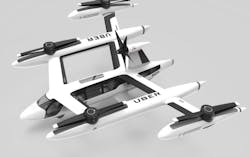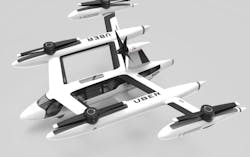Uber defines Uber Elevate mission, vehicle requirements
DALLAS. Engineers and officials at Uber Technologies Inc. in Dallas have released mission and air vehicle requirements for the company's Uber Elevate network.
Uber Elevate’s objective is to implement an Urban Air Mobility (UAM) ridesharing network in cities across the world. A multi-modal, on-demand service will reduce riders’ commute times and free up ground space in and around cities. The Uber Elevate Network will offer an on-demand air rideshare option to some of our 75+ million monthly active users through our customer-facing mobile app. This service will be known to consumers as uberAIR, in-line with current product offerings (uberX, uberPOOL, etc.).
To serve this market, Uber engineers have defined a set of preliminary missions and requirements for Electric Vertical Takeoff and Landing (eVTOL) aircraft based on the envisioned Elevate Network. These requirements have been developed by leveraging extensive analysis of current and predicted demand, a thorough understanding of the capability of the technology, and a focus on creating the optimal rider experience.
In order to bring this transformational technology to riders as quickly as possible, flight demonstration in 2020 will provide testing validation of the eVTOL community noise and user acceptability, as well as the vehicle safety and performance. Flights from 2023 onward will be conducted with certified aircraft as revenue producing operations.
VTOL: Vehicles must have Vertical Takeoff and Landing capability with short duration hover. Vehicles must also convert to wingborne flight to achieve the necessary speed and range.
Safety: Vehicles must be able to perform a safe vertical landing in the event of a critical failure, including a collision with a bird, in any phase of flight. In addition, we recommend that vehicles have a Ballistic Recovery System or autorotation capability for emergency situations.
Noise: Uber engineers are developing noise standards for UAM eVTOL aircraft that will use detailed time integrated annoyance metrics to ensure community friendliness. This involves designing the aircraft to achieve specific signatures that can map into background city noise soundscapes. Simplified comparative sound levels experienced by observers should be on the order of 15 dB quieter than existing light helicopters, or about 70 dB SEL at 500 ft vs 85 dB for typical helicopter of similar weight.
Energy Storage: Uber’s network will only operate vehicles with fully battery-electric energy storage. Uber has initiated a program to provide a solution for its partners that achieves 300 Wh/kg at the pack level, and at least 3C charge and discharge. Skyports will not be designed to accommodate vehicles with liquid hydrocarbon fuels.
Skyports: Vehicles on Uber's network will operate only from Skyports, which are VTOL hubs with multiple takeoff and landing pads, as well as charging infrastructure. Vehicles should not require ground equipment that is specific to the vehicle model for passenger ingress/egress.
Charging: Uber engineers are working with our partners to develop a rapid charging capability (up to 600 kW); the vehicles must be able to interface with this infrastructure. Vehicles are expected to charge for 5 to 15 minutes between flights.
Pilots: Uber engineers expect that on day one, vehicles will have the avionics and sensors needed for autonomous flight. However, they will be piloted in our first years while data is collected to prove the safety of autonomous systems. While not required by FAA, Uber will require the pilot to be physically separated from the passengers to achieve maximum safety.
Network Communications: Uber engineers will work with our partners to develop a secure bi-directional API for network communication. For example, the vehicle must be able to receive precise flight plans and report position and battery state. All vehicles must have the required equipage to fly in Class B airspace.
Payload: Vehicles must have three or four passenger seats in addition to the pilot. For four passengers with luggage and a pilot, assume an 1100 lb max payload. While the economics favor four seats, we will also accept three passenger seats at a 960 lb max payload. Ground
Taxi: Vehicles must be able to perform a powered wheeled ground taxi without props or rotors spinning. We intend for vehicles to travel on the ground for up to 300’ with an intended ground taxi speed of approximately 5 ft/sec.
Size: Due to the limited size of the Skyports in urban environments, vehicle footprint must not exceed 45’ in its max dimension, including fully extended rotors. The max takeoff weight must not exceed 7000 lbs.
Missions Range: Vehicles should be able to fly 60 miles while still having enough energy to fly the reserve mission. This must be achieved at the battery’s end of life state (≈80% of original capacity).
Reserves: The sizing mission assumes that reserve must be the greater of either: a balked landing at the original destination with a 6 mile cruise to an alternate landing site; or being able to execute a normal landing with the failure of a single battery series element. The actual reserve energy required to execute a flight will be determined operationally and through working with regulators. Note that the effect of battery aging (decreased capacity and increased internal impedance) must be accounted for in evaluation of battery reserve.
Cruise Condition: Vehicles should achieve a minimum 150 mph cruise speed and have the ability to cruise at a range of speeds encompassing a 30 mph difference. While network analysis favors faster vehicles, Uber engineers will accept speeds as low as 135 mph. Cruise should be performed at 1000 feet above ground level (AGL). They will initially operate under Part 135 only in visual meteorological conditions (VMC) with a path to autonomy enabled near-all-weather operation.
Repeatability: The vehicle must be able to operate continuously for at least 3 hours while flying 25 mile missions at the battery’s end of life state (≈80% of original capacity). Uber engineers define continuous operations as needing to charge for no more than 5 minutes between flights, such that the limit on throughput is only the time to unload and load the passengers.
Uber engineers believe that this repeatability will be key to maximizing throughput.
1) Battery Rapid Charge Ceiling (≈90% SoC) - Above some upper SOC, charge rate will begin to decrease from maximum capability.
2) Minimum SoC for Dispatch - Must be above this SoC to take off - includes energy to complete the next mission and reserve without dropping below the battery floor.
3) Minimum Reserve SoC - Do not pass this line in nominal operations - used for reserve mission without passing battery floor.
4) Battery Floor (≈10% SoC) - At some lower SOC, current spikes and voltage drops precipitously. This section of the battery should not be counted as reserve. Note: All SOC values are nominal values used for sizing - in practice, they will depend on many factors such as power requirements, battery state of health and internal resistance, and operational constraints.

